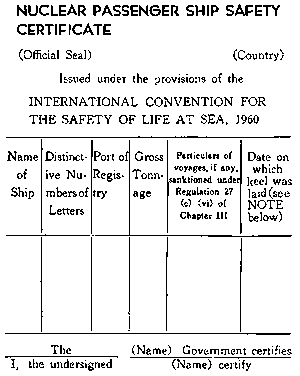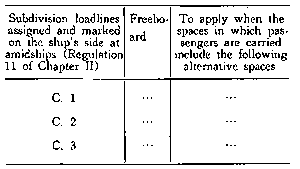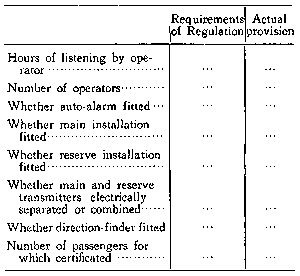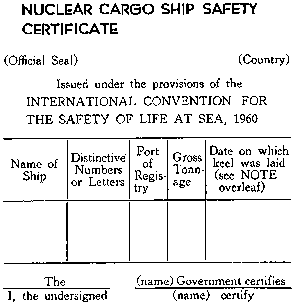|
1960年条約における原子力船に関する決定事項(仮訳) 「第1章 一般規定」への追加 第2規則 (定義) 「第8章 原子力船」の新設 第1規則 (適用)本章の規定は軍艦を除くすべての原子力船に適用する。 第2規則 (本章以外の規定の適用)本条約の本章以外の規定は、本章の各規定により修正されたものを除き、原子力船にも適用する。 第3規則 (免除)原子力船は如何なる場合においても本条約の各規定につき免除されることはない。 第4規則 (原子炉設置の許可)原子炉の設計、構造並びに、検査および組立の基準については主管官庁の許可および承認を受けなければならない。又これらは放射線の存在の下において検査を行なうための考慮を払わねばならない。 第5規則 (原子炉の船舶への設置の適応性)原子炉の設置に際しては海上における原子力船のあらゆる航海状態を考慮して設計されねばならない。 第6規則 (放射性に対する安全性の確保)主管官庁は海上および港内において、乗組員、乗客、公衆、水路、食物または水産資源に対して、不当な放射線の曝射又は他の核的災害を生じないことを確かめるための立法措置を講ずること。 第7規則 (安全審査書)安全審査書は原子力船が海上および港内において、乗組員、乗客、公衆、水路、食物又は水産資源に対して、不当な放射線の曝射又は他の災害をもたらさないことを確めるため、原子力プラント及び原子力船の安全性の評価を行なうために作成されねばならない。主管官庁は、安全審査書の内容が妥当であると認めたときはこれを承認しなければならない。又安全審査書は常に現状に合致していなくてはならない。 2.安全審査書は、原子力船が訪問しようとする国の締約政府に対して原子力船の安全性を評価し得るよう、訪問に先立って十分なる時間的余裕をもって提供されなければならない。 第8規則 (運転方法書)原子力プラントの運転および安全性を十分に確保するために必要なあらゆる事項について、原子力プラントの運転者の手引となる詳細に記述された運転方法書を作成し、これを主管官庁の承認を受けた上で、その写を船舶に備えておかなければならない。又運転方法書は常に現状に合致していなければならない。 第9規則 (検査)原子力船の検査は、放射線の存在により制限されるものを除き、第1章の第7規則、第8規則、第9規則および第10規則の各規定により要求されるものを含むものとする。更に、原子力船の検査は安全審査書における各特別な要求事項についてもこれを含むものとする。原子力船の検査は、第1章の第8規則および第10規則の規定に拘らず、すべて1年を越えざる期間毎に行なうものとする。 第10規則 (証書)第1章第12規則(a)および第1章第14規則の各規定は原子力船には適用しない。 2.「原子力客船安全証書」は原子力客船に対し、本船が第2章、第3章、第4章及び第8章並びに本条約の他の関連規定に合致しているものであることを検査した上で交付されるものとする。 3.「原子力貨物船安全証書」は原子力貨物船に対し、本船が第1章第10規則に規定する検査における貨物掛こついての要求を満足し、且つ第2章、第3章、第4章及び第8章並びに他の関連規定に合致しているものであることを検査した上で交付されるものとする。 4.「原子力客船安全証書」および「原子力貨物船安全証書は、本船が原子力船であること、本条約の第8章のすべての規定に合致していること、および、本船に対して承認された安全審査書に合致しているものであることを明記するものとする。 5.「原子力客船安全証書」および「原子力貨物船安全証書」の有効期限は12ヵ月を超えないこと。 6.「原子力客船安全証書」及び「原子力貨物船安全証書」は主管官庁又はそれにより認可された人又は機関により交付されねばならない。この何れの場合においても主管官庁は、その証書について全責任を有するものである。 第11規則 (特別な監督)原子力船は、第1章第19規則による監督に加えて本船が有効なる原子力船安全証書を備えているか否か。および本船が海上又は港内において、乗組員、乗客、公衆、水路、食物又は水産資源に対し不当な放射線の曝射又は他の災害を生じないということを確認するために締約政府の港に入る前および港の中において行なわれる特別な監督に従わねばならない。 第12規則 (海難)災害が周辺に及ぶと思われる事故が発生した場合には、原子力船の船長は直ちに主管官庁に通報すること。亦船長は直ちに本船が位置する海域または損傷状態のまま近接せんとする海域の国の関係政府機関に対しても通報すること。 原子力船についての「勧告」 1.原子力船の一般的安全性
(b)原子力船についてはその一般構造強度並びに、原子炉室内および周辺の局部強度について特別な考慮を払うべきである。
(c)原子力船は、あらゆる積荷状態において、少くとも如何なる二つの隣接した主要水密区劃が浸水した場合においても浮揚しかつ十分なる復原性を持っているべきである。
(d)防火設備および水密度については、少くとも本条約の最高の基準に同等であること。 2.原子力プラントについての一般的要求
(b)原子炉装置は如何なる運転状態および沈没を含めた事故状態においても無制御な連鎖反応を防止するよう設計されておらねばならない。
(c)1基の原子炉のみをもつ原子力プラントを設置した原子力船は、未だ原子炉の信頼性が証明されていないので、航海し得る速力で船を推進することの出来る非常推進プラントを装備しなければならない。原子力船が領海内を航行する時は、非常推進プラントは常に利用し得る状態にしておかねばならない。
(d)原子カプラントは同様な在来船のものと同等の操縦性を確保しうる如きものであること。
(e)原子力プラントの中の在来部分(非原子力部分)についての予備非常部品についての要求は同様な在来船に対する要求に合致すること。予備及び非常用原子力部会については、使用される原子力プラントの型式に関連して考慮し且つ開発されねばならない。
(f)原子炉装置の安全運転に欠くことの出来ない予備系統は万一の事故に備えて主系統と分離しなければならない。
(g)非常電源は原子炉装置を安全に停止し且原子炉を安全な状態に保持するために必要な部分に電力を供給し得るに足るものを装備せねばならない。
(h)原子炉室には原子炉装置に必要なるものを除き可燃性物質は使用しないこと。
(i)空気又は水と危険な程度に化学的反応を起す如き原子炉材料はその安全性が確認されない限りは使用してはならない。
(j)主機械および原子炉装置は、船の傾斜、加速度、振動について航海状態において満足に運転されるよう設計されなければならない。
(k)原子炉冷却装置は原子炉から崩壊熱を安全に除去し得るものであり且つ、船舶の復原性限度内のヒールおよび傾斜の状態で、予想し得る運転時および事故時に過熱状態になることを防止し得るものであること。崩壊熱除去装置の欠陥が原子炉格納容器からの放射線又は有害物質の危険量の放出を生じないこと。
(l)適切な原子炉制御、防護装置および計測器を装備すること。
(m)原子炉装置を格納施設の外側から制御し得るよう必要な制御装置および計測器を設けること。 3.原子炉装置の防護および格納施設
(b)原子炉装置は、事故の時に放射線又は有害物質の危険量が、船内の作業区域、居住区域おび船の周辺に救出されることを防止するための格納施設、系統、装置を設けねばならない。これらは考えられるすべての事故の状態のもとにおいて満足なものであることを確かめるために適当な試験を行わねばならない。
(c)格納施設、系統、装置は衝突又は坐礁時における事故を最小にするような場所に配置されること。構造上、正常なる状態における原子炉の安全性に悪影響を及ぼすことなく、船舶が難破した際に原子炉又はその主要部分を船舶から取り出し得るようにすること。
(d)原子炉装置の内外における火災により格納施設、系統および装置が損われないためおよび原子炉装置を安全に停止し、安全な状態に保持するための設備を備えること。 4.遮蔽および放射線防護
(b)適切な放射線防護に関する基準、取扱いは、すべての原子力船のために作られねばならない。原子力プラント関係者のこれらに関する知識は、主管官庁によって定期的に試験されねばならない。
(c)適当な個所に放射線監視機器を設置すること。これらの監視機器は、放射線が予め定められた安全レベルを超えた場合に警報を発すること。 5.放射性廃棄物
(b)これら放射性廃棄物処理施設には監視装置を備えること。これら監視装置は放射線が予め定められた安全レベルを超えた場合に警報を発すること。
(c)公海における廃棄物処理の放射線の最大許容レベルは、国際的基準が確立された時にはこれに従うこと。 6.燃料装荷およびその取扱い
(b)燃料の取出し、燃料の交換およびその取扱いは、人間に対して不当な放射線の曝射をすることなく、又周辺に対して放射性又は有害な物質の危険な放出を生じないようにして行なわれなくてはならない。 7.乗 組 員 8.運転方法書 9.安全審査書
(b)安全審査書の内容は上に例記したものに限定されるものではなく、必要と考えられる追加資料も提供されるべきである。完成された安全審査書は、同一船型の同一型式の原子炉のものの最初のものについて作成されねばならない。運転経験と安全性が実証された同船型、同型式の原子炉の第2船以降のものについては、以前の設計との差異についての解析のみにて承諾されるであろう。 10.原子力船受入れについての要求の公表 11.特別な監督
(a)原子力プラント及び附属機器の運転日誌を最終寄港地を含めて1週間乃至1ヵ月の適当な期間にわたって検証すること。
(b)原子力プラントが妥当に証明されたものであるか否か、および運転方法書の要求する定期的な点検が行なわれているか否かを確かめること。
(c)原子力船の内部および周辺の住民の近づき得る原子力船の近傍における放射線レベルが、運転方法書に述べられた最大許容レベルを超えていないことを船の記録で検証するか又は直接測定するかして確かめること。
(d)原子力船上に貯蔵されている放射性廃棄物の数量及び放射能を船の記録又は直接測定によって確かめること。又廃棄物処理の方法及び予定について確かめること。
(e)原子炉施設の防護および格納施設が完全であるか否かの確認、およびこれら施設が損傷した場合の対策が運転方法書の要求と合致しているか否かを確認すること。
(f)狭い水路を航行する時に特に信頼性を必要とする在来機器および非常用機器が有効に使用し得る状態にあるか否かを確認すること。 CHAPTER I GENERAL PROVISIONS PART A-APPLICATION, DEFINITIONS, ETC.
For the purpose of the present Regulations, unless expressly provided
otherwise : - CHAPTER VIII NUCLEAR SHIPS Regulation 1 Application Regulation 2 Application of other Chapters Regulation 3 Exemptions Regulation 4 Approval of Reactor Installation Regulation 5 Suitability of Reactor Installation
for Service on board Ship Regulation 6 Radiation Safety Regulation 7 Safety Assessment
(b) The Safety Assesment shall be made available sufficiently in advance
to the Contracting Governments of the countries which a nuclear ship
intends to visit so that they may evaluate the safety of the ship. Regulation 8 Operating Manual Regulation 9 Surveys
They shall in all cases, not withstanding the provisions of Regulations
8 and 10 of Chapter I, be carried out not less frequently than once
a year. Regulation 10 Certificates
(b) A Certificate, called a Nuclear Passenger Ship Safety Certificate
shall be issued after inspection and survey to a nuclear passenger
ship which complies with the requirements of Chapters II, III, IV,
and VIII, and any other relevant requirements of the present Regulations.
(c) A Certificate, called a Nuclear Cargo Ship Safety Certificate
shall be issued after inspection and survey to a nuclear cargo ship
which satisfies the requirements for cargo ships on survey set out
in Regulation 10 of Chapter I, and complies with the requirements
of Chapters II, III, IV and VIII, and any other relevant requirements
of the present
(d) Nuclear Passenger Ship Safety Certificates and Nuclear Cargo Ship
Safety Certificates shall state: "That the ship, being a nuclear
ship, complied with all requirements of Chapter VIII of the Convention
and conformed to the Safety Assessment approved for the ship."
(e) Nuclear Passenger Ship Safety Certificates and Nuclear Cargo Ship
Safety Certificates shall be valid for a period of not more than 12
months.
(f) Nuclear Passenger Ship Safety Cerilficates and Nuclear Cargo Ship
Safety Certificates shall be issued either by the Administration or
by any person or organization duly authorized by it. In every case,
that Administration assumes full responsibility for the certificate. Regulation 11 Special Control Regulation 12 Casualties RECOMMENDATIONS APPLICABLE TO NUCLEAR SHIPS Note: Throughout the following Recommendations, "present Convention"
means the "International Convention for the Safety of Life at
Sea, 1960."
Attention is drawn to the Regulations conceming nuclear ships in.
Chapter VIII of the present Convention. 1. General Safety of Nuclear Ships
(b) Special attention should be given to general strength of structural
strength of nuclear ships and to the local structures in and around
the reactor compartment.
(c) A nuclear ship should remain aaoat and have sufficient stability
when not less than any two adjacen tmain watertight compartments are
flooded, in all anticipated conditions of loading. (d) Fire protection systems and the watertight integrity should be at least equivalent to the highest standards of the present Convention. 2. General Requirements of Nulcear power Plant
(b) The reactor installation should be designed to prevent an uncontrolled
chain reaction under all foreseeable operational and accident conditions
including sinking of the ship.
(c) A nuclear ship equipped with a single-reactor nuclear power plant,
the dependability of which has not been proven, Should be provided
with an emergency propulsion plant capable of propelling the ship
at a navigable speed. Such emergency propulsion plant should be in
a state of readiness whenever the ship is navigating in territorial
waters. (d) The nuclear power plant should be such as to ensure manoeuvrability equivalent to that of a similar conventional ship.
(e) Requirements for standby emergency components for the conventionai
portions of the nuclear power plant should be in accordance with those
for a similar conventional ship. Standby and emergency nuclear components
should be considered and developed in relation to the type of nuclear
power plant used.
(f) Where standby systems are essential to the safe operation of the
reactor installation, they should be so separated from the main systems
as to give maximum protection in the event of an accident.
(g) An emergency source of power should be provided which is capable
of fumishing power to the components necessary for safely shutting
down the reactor installation and retaining it in a safe condition.
(h) The reactor compartment should contain no inflammable materials
other than those necessary for use in the reactor installation.
(i) Reactor materials which are chemically reactive with air or water
to a dangerous degree should not be used unless it can be shown that
adequate safeguards are incorporated in the particular stem.
(j) The machinery and reactor installation should be designed to operate
satisfactorily under seagoing conditions having regard to the ship's
attitude, accelerations and vibrations.
(k) Reactor cooling systems should provide for the safe removal of
decay heat from the reactor and should prevent excessive temperature
conditions under all foreseeable cperational and accident conditions
at angles of heel and list within the stability range. Failure of
decay heat removal facilities should not result in the release of
hazardous amounts of radioactive or toxic materials from the enclosure
of the reactor installation.
(l) Adequate reactor controls. protective devices and instrumentaLtion
should be provided. 3. Protection and Enclosure of Reactor Installation
(b) The reactor installation should be provided with enclosures, systems,
or arrangements which in the event of damage to its components will
prevent the release of hazardous amounts of radioactive or toxic materials
into service and accommodation spaces and the ship's environment.
These outer enclosures, systems, or. arrangements should be subjected
to suitable tests to demonstrate satisfactory performance under all
foreseeable conditions of accident.
(c) The enclosures, systems, or arrangements should be kcated in such
a manner as to minimize damage in the event of collision or grouding.
In construction, arrangements should be made, if practicable, to facilitate
the possible salvage of the reactor or of its essential parts from
the vessel in the event of shipwreck, without adversely affecting
the safety of the reactor instllation under normal conditions.
(d) Facilities should be provided to ensure that fires within and
without the reactor installation do not impair the integrity of the
enclosures, systens, or arrangements provided, or the arrangements
provided for safely shutting down the reactor installation and retaining
it in a safe condition. 4. Shielding and Radiation Safety
(b) Maintenance and operation instructions in regard to appropriate
radiation protection should be worked out for every nuclear ship.
Knowledge of these instructions by the nuclear power plant personnel
should be periodically checked by the Administration. (c) Radiation monitoring instruments should be installied at appropriate locations. These should give waning in the event of any radiation exceeding a predetermined safe level. 5. Radioactive Wastes
(b) Monitoring devices should be provided for these waste disposal
systems. These should give waming and, if necessary take action, in
the event of any radiation exceeding a predetermined safe level.
(c) The maximum permissible levels oi radiation for waste disposal
on the high seas should be in accordance with international levels
when established. 6. Fuelling and Maintenance
(b) Arrangements should be provided to ensure that de-fuelling, refuellig,
servising and maintenance can be carried oui without unacceptable
exposure of personnel to radiation and without hazardous release of
radioactive or toxic materils to the environment. 7. Manning 8. Operating Manual 9. Safety Assessment
(b) The content of the Safety Assessment should not be considered
limited to the information suggested herein; and such additional specific
data as necessary should be made available. The complete Safety Assessment
should be prepared for the first installation of a reactor type in
a ship type. For second and following generation reactor and ship
types where performance and safety have been demonstrated, accpetance
may be based on an analysis of deviations from the previous design. 10. Publication of Requirements 11. Special Control
(a) Examination of the daily log of the behaviour of the nuclear power
plant and equipment, covering a reasonable period of between one week
to one month including the stay in the last port.
(b) Determination that the nuclear power plant is properly certified
and that any periodic checks required by the Operating Manual have
been complied with.
(c) Determination that radiation levels in areas within the ship and
in the vicinity of the ship which are accessible to shore personnel
are not in excess of maximum permissible levels specified by the Operating
Manual to be determined by examination of the ship's records or by
independent measurement.
(d) Determination of the quantity and activity of radionctive waste
stored abord the ship by examination of the ship's records or by independent
measurement, and of the prccedures and programme for any disposal.
(e) Determination that the reactor installation protection and enclosure
is intact, and that any programme involving a breach of its integrity
complies with the requirements of the Operating Manual.
(f) Determinaton that convetional and emergency arrangements and equipment,
the reliability of which is essential when navigating in narrow waters,
are in efhcient operating condition. Form of Safety Certificate for Nuclear Passenger Ship
NUCLEAR PASSENGER SHIP SAFETY CERTIFICATE
I. That the above-mentioned ship has been duly surveyed in accordance with the provision of the Convention referred to above. II. That the ship, being a unclear ship, complied with all requirements of Chapter VIII of the Convention and conformed to the Safety Assessment approved for the ship. III. That the survey showed that the ship complied with the requiremets of the Regulations annexed to the said Convention as regards:- (1) the structure, main and auxiliary boilers and ohter pressure vessels and machinery ;
IV. That the life-saving appliances provided for a total number of・・・・・・ V. That the ifeboats and liferafts were equipped in accordance with the provisions of the Regulations. VI. That the ship was provided with a linethrowing appliance and portable radio apparatus for survival craft, in accordance with the provisions of the Regulations. VII. That the ship complied with the reguirements of the Regulations as regards radiotelegraph installations, viz: -
VIII. That the functioning of the radiotelegraph installations for motor lifeboats and/or the portable radio apparatus for survival craft, if provided, complied with the provisions of the Regulations. IX. That the ship complied with the requirements of the Regulations as regards fire-detecting and fire-extinguishing appliances and was provided with navigation lights and shapes, pilot ladder, and means of making sound signals and distress signals, in accordance with the provisions of the Regulations and also the International Collision Regulations. This certificate is issued under the authority of the Goverment. It will remain in force until Issued at the day of 19 . Here follows the seal or signature of the authority entitled to issue the certificate. (Seal) If signed, the following paragraph is to be added:- The undersigned declares that he is duly authorised by the said Government to issue this Certificate. (Signature) NOTE In the case of a ship which is converted as provided tin Regulation 1 (b) (i) of Chapter II, the date on which the work of conversion was begun should be given. Form of Safety Certificate Nuclear Cargo Ship NUCLEAR CARGO SHIP SAFETY CERTIFICATE
I. That the above-mentioned ship has been duly surveyed in accordance with the provisions of the Convention referred to above. II. That the ship, beging a nuclear ship, complied with all requirements of Chapter VIII of the Convention and conformed to the Safety Assessment approved for the ship. III. That the survey showed that the ship satisfied the requirements set out in Regulation 10 of Chapter I of the Covnention as to hull, machinery and equipment, and complied with the relevant require- ments of Chapter II. IV. That the life-saving appliances provide for a total number of persons and no more, viz:- V. That the lifeboats and liferafts were equipped in accordance with the provisions of the Regulations annexed to the Convention. VI. That the ship was provided with a linethrowing apparatus and portable radio apparatus for survival craft in accordance with the provisions of the Regulations. VII. That the ship complied with the requirements of the Regulations as regards radiotelegraph installations, viz: - VIII. That the functioning of the radiotelegraph installations for motor lifeboats and/or the portable radio apparatus for survival craft, if provided, complied with the provisions of the Regulations. IX. That the inspection showed that the ship complied with the requirements of the said Convention as regards fire-extinguishing appliances and was provided with navigation lights and shapes, pilot ladder, and means of making sound signals and distress signals in accordance with the provisions of the Regulations and the International Collision Regulations. X. That in all other respects the ship complied with the requirements of the Regulations so far as these requirements apply thereto. This certificate is issued under the authority of the Government. It will remain force until Issued at the day of 19 . Here follows the seal or signature of the authority entitled to issue the certificate. If signed, the following paragraph is to be added: - The undersigned declares that he is duly authorised by the said Government to issue this Certificate. (Signature) NOTE |



